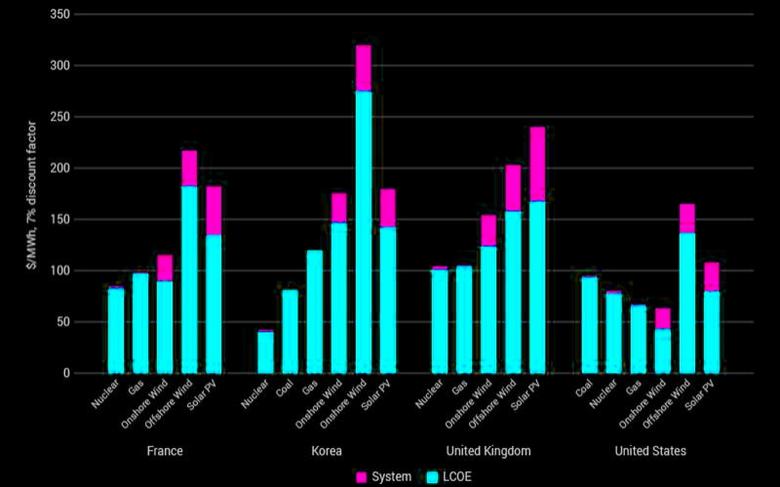
CHINA'S ENERGY WILL DOUBLE

By Brian Wang
NEXTBIGFUTURE - May 8, 2020 - The coronavirus crisis has US corporate interest rates are in the 1.8-4.1% range. China has a 10-year government bond yield of 2.6%. Low rates make new nuclear energy and other high capital cost projects more affordable. We have to adjust the cost calculations for solar and wind to factor in the shorter usable life of solar panels and wind turbines. We also have to adjust solar and wind energy prices for the natural gas backup they require to handle the fluctuations in their power production.
A 2015 NEA report made the important point regarding LCOE: At a 3% discount rate, nuclear is the lowest cost option for all countries.
In China, it is estimated that building two identical 1000 MWe reactors on a site can result in a 15% reduction in the cost per kW compared with that of a single reactor.
It should also be noted that it is irrelevant if the handful of nuclear power plants that the US and Western Europe have tried to make in the last 30 years has been expensive. What matters is the cost efficiency of uprates and plant life extensions to the older fleet. The world is building more energy in Asia. The US and Europe are mostly not building new power plants. They are just working on some efficiency increases. China generates more electricity than Europe and the USA combined and China will double again in twenty years. South Asia (ASEAN and India) will be the next to scale up energy construction. We need to compare the costs where the power is actually being built. People should also note that even the Bloomberg New Energy group (very pro new energy and pro-solar and wind) expect China and Asia to still be operating coal power past 2050. Coal is super polluting and super deadly. So those that care about air pollution and saving lives and CO2 for climate change should prefer nuclear energy over coal.
A decade or two of low-interest rates from coronavirus will ensure China will build a lot of new nuclear energy over the next 20-30 years.
There is cost analysis from the Institute for Energy Research.
There are detailed studies of wind turbines and they typically have planned operating lives of 20 years. In particular, offshore wind turbines face harsh conditions that cause them to breakdown. Pro-wind people hope wind turbines can last 35 years. There are some small and old wind turbines that have lasted 35 years but they are inefficient old technology.
The National Renewal Energy Lab has an analysis of the costs and economics to repower wind turbines. In general, repowering is 10% lower cost than building an entirely new turbine.
The costs to keep a nuclear plant operating out to 80 years remain at about $70-100 per kilowatt. The operating and maintenance costs do not have a large escalation and there is usually no need for an extensive rebuild. The CANDU reactors can have extensive maintenance but most other pressure water and boiler water reactors do not.
Wind turbines and solar power panels deteriorate in the wind and sun. They lose about 1-2% of their energy generation each year.
The Institute for Energy Research factors in the standard use of natural gas to back up large wind and solar power installations.
The overnight cost of solar and wind power usually do not factor in that they are comparing against nuclear, hydro and coal plants that can get extensions from standard 40-year operation to 80-100 years.
China and South Korea have been building most of the new nuclear reactors. They happen to be the countries completing those projects mostly on time in 4-6 years and with good costs. Lower interest (discount rates) below 3% will make new nuclear power cost less than 3 cents per kwh. (less than $30 per MWH).
-----



















